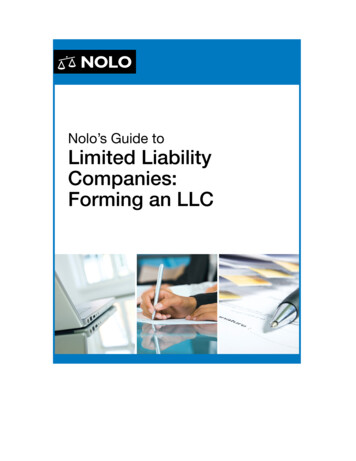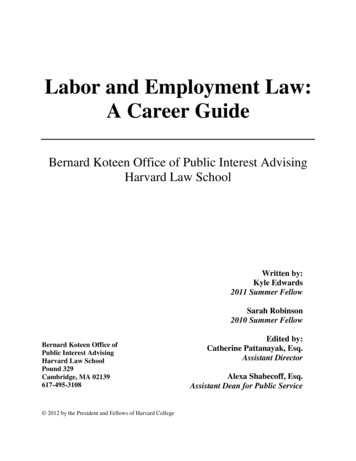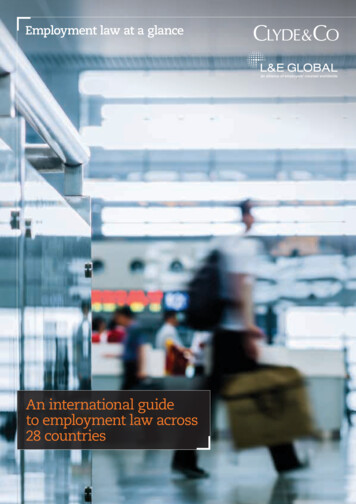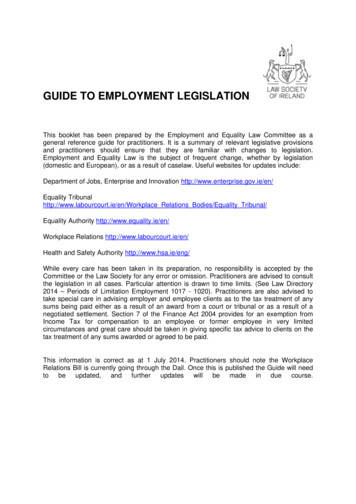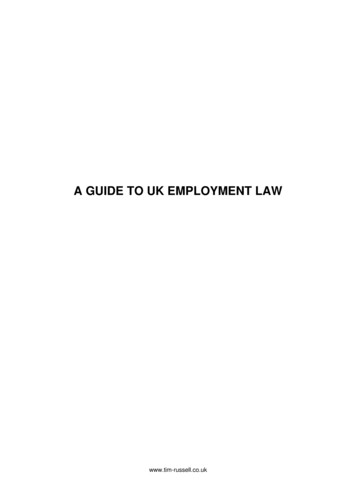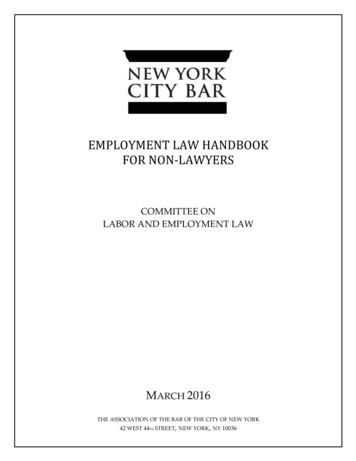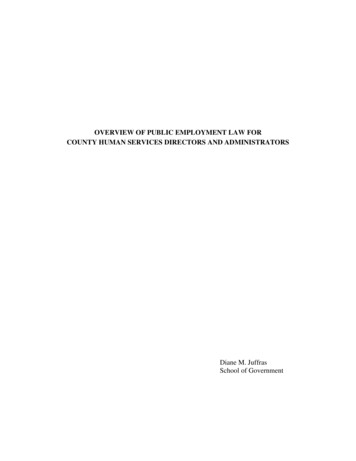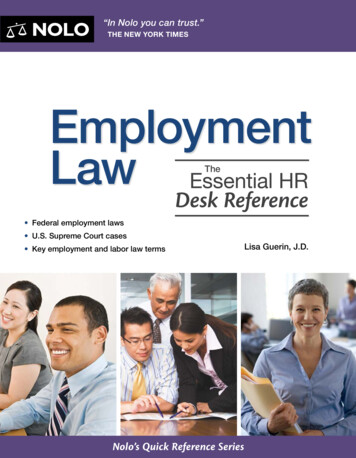
Transcription
“In Nolo you can trust.”THE NEW YORK TIMESEmploymentLaw DeskEssential HRReferenceThe Federal employment laws U.S. Supreme Court cases Key employment and labor law termsNolo’s Quick Reference SeriesLisa Guerin, J.D.
1st editionEmployment LawThe EssentialHR Desk ReferenceLisa Guerin, J.D.LAW for ALL
FIRST EDITIONMARCH 2011Cover DesignJALEH DOANEEditorRICHARD STIMBook DesignTERRI HEARSHProofreadingROBERT WELLSPrintingDELTA PRINTING SOLUTIONS, INC.Guerin, Lisa, 1964Employment law : the essential HR desk reference / by Lisa Guerin. -- 1st ed.p. cm.Summary: “An A-Z reference encyclopedia, with more than 200 entries defining andexplaining employment and labor law topics. The entries combine a summary of thelaw with real life case references, pop culture references, and statistics and trends”-Provided by publisher.ISBN-13: 978-1-4133-1333-8 (pbk.)ISBN-10: 1-4133-1333-7 (pbk.)ISBN-13: 978-1-4133-1359-8 (e-book)ISBN-10: 1-4133-1359-0 (e-book)1. Labor laws and legislation--United States. I. Title.KF3369.G84 2011344.7301--dc222010042817Copyright 2011 by Nolo. All rights reserved. The NOLO trademark is registered inthe U.S. Patent and Trademark Office. Printed in the U.S.A.No part of this publication may be reproduced, stored in a retrieval system, or transmitted in any form or by any means, electronic, mechanical, photocopying, recording,or other wise without prior written permission. Reproduction prohibitions do notapply to the forms contained in this product when reproduced for personal use.For information on bulk purchases or corporate premium sales, please contact theSpecial Sales Department. Call 800-955-4775 or write to Nolo, 950 Parker Street,Berkeley, California 94710.Please noteWe believe accurate, plain-English legal information should help you solvemany of your own legal problems. But this text is not a substitute forpersonalized advice from a knowledgeable lawyer. If you want the help of atrained professional—and we’ll always point out situations in which we thinkthat’s a good idea—consult an attorney licensed to practice in your state.
SAMPLEAabsenteeismAbsenteeism refers to an employee’s pattern of failing to show upat work or to the rate at which a group of employees don’t showup for work. (For example, if a company or department has a 10%absenteeism rate, that means one in ten of its employees are likely tobe absent on any given day.)The term is usually reserved for employees who are absent sooften that it causes problems at work, employees whose absences aresuspicious in some way (for example, who routinely call in sick at theend of a vacation or long weekend), or employees who do not followrequired procedures for absences (like calling in sick or giving noticeof vacation). An employee who is out of work for a few days with theflu would not be accused of “absenteeism,” for instance.What companies do about absenteeism. Companies use a numberof strategies to manage absenteeism, including adopting proceduresemployees must follow to take time off, disciplining employees whoignore the rules, having supervisors follow up with employees whocall in sick, and combining vacation, sick, and other leave into onepaid time-off entitlement, which means an employee who calls insick at the last minute is losing a day that could otherwise have beenused for vacation. Policies like these make it more difficult—orless appealing—for employees to take unscheduled time off at thelast minute, which helps the employer manage its workforce andworkload.1
absenteeismSAMPLEAWho’s Absent the Most?According to 2009 data from the federal Bureau of Labor Statistics(BLS), the employees who missed the highest percentage of workhours to absences each year work in the health care industry.Government workers had the second highest percentage, followedby a tie for third among protective service employees, communityand social service employees, personal care providers, office andadministrative support employees, and production workers. (Thefigures are based on time not worked because of illness, child careproblems, personal obligations, and so on; time spent on vacation orholidays wasn’t included.)No-fault attendance policies. Some employers use “no-fault”attendance policies, which typically penalize employees for havingmore than a set number of unexcused absences per year, whetherthe employee is sick, has a family emergency, or takes a last-minutepersonal day. (Some policies count even scheduled absences, suchas vacations or time off for scheduled surgery, toward an employee’stotal, and allow a higher number of absences before discipline kicksin.) For example, a no-fault attendance policy might give employeesa point for each unexcused absence, then provide that five pointsin a year merits a verbal warning, eight points results in a writtenwarning, and ten points in a year is a firing offense.Policies like these can lead to legal problems if the employeeis penalized for absences that are protected under the Family andMedical Leave Act (FMLA) or the Americans with Disabilities Act.The FMLA allows employees to take time off if a serious healthcondition requires it, even if the need for leave was not foreseeable.For example, if an employee has a chronic condition that flares upand makes it impossible to work, that employee may use FMLAleave. An employer that counts that absence against the employeehas violated the FMLA.2
ADARelated terms: Americans with Disabilities Act; Family and MedicalLeave Act; paid time off (PTO); presenteeism; sick leave; vacation.ADASee Americans with Disabilities Act.3ASAMPLEExample: June Manuel began working for Westlake PolymersCorporation in 1986. Her absenteeism was an ongoing problemduring her employment, and she was warned that her jobwould be in jeopardy if her attendance didn’t improve. In 1991,Westlake adopted a no-fault attendance policy, which countedevery absence against the employee no matter why the employeemissed work. Manuel was warned four times in 1992 thather attendance had to improve immediately or she would besuspended or fired.In October 1993, Manuel got permission to take a Friday offto have an ingrown toenail removed. She was expected to returnto work the following Monday, but suffered complications,including an infection and swelling. She missed more than amonth of work following this procedure. When Manuel took afew days off work sick several months later, she was fired.She sued Westlake and a federal Court of Appeals allowedher lawsuit to go forward. Why? Because the FMLA becamelaw in August 1993, and her month-long absence may havebeen protected leave under the law. If so, counting that absenceagainst her under the no-fault attendance policy was a violationof the FMLA. Westlake argued that Manuel didn’t give noticeof her need for leave, as the statute requires, because she nevermentioned the FMLA. The court found that this didn’t matter:Once the employee gives notice of leave for a medical condition,it’s up to the employer to figure out whether the FMLA applies.(The court didn’t offer an opinion as to whether Manuel’singrown toenail was a serious health condition covered by theFMLA.) Manuel v. Westlake Polymers Corp., 66 F.3d 758 (1995).
ADAAASAMPLEAADAAASee Americans with Disabilities Act.ADEASee Age Discrimination in Employment Act.administrative employeeAlthough many people refer to secretaries and others who keep anoffice running smoothly as “administrative employees” (or “admins,”for short), this term has a more specific legal meaning. It refers toa category of employees who are exempt from the minimum wageand overtime requirements of the federal Fair Labor StandardsAct (FLSA). Even if they work more than 40 hours a week, theseemployees aren’t entitled to get overtime.Two requirements must be met for a worker to qualify as anadministrative employee: a salary test and a job duties test. Underthe salary test, the employee must earn at least 455 per week andbe paid on a salary basis. Workers are paid on a salary basis if theyreceive their full salary for any week in which they perform anywork, regardless of how many hours they work or the quality oramount of work they do. (There are a handful of exceptions to thisrule, covered in “pay docking.”)An employee must also perform certain job duties to qualify.An administrative employee’s primary duty must be office or othernonmanual work directly related to the management or generalbusiness operations of the employer or its customers. Examplesinclude performing functions like tax, finance, human resources,marketing, regulatory compliance, auditing, or insurance. This workmust include the exercise of discretion and independent judgmentregarding matters of significance. This might include the authorityto make decisions, set policy, carry out important assignments,or commit the employer to a particular course of action with asignificant financial impact on the company.4
affirmative actionARelated terms: exempt employee; Fair Labor Standards Act; minimumwage; overtime; pay docking; professional employee.affirmative actionSAMPLEPractices that are intended to promote opportunity for membersof historically disadvantaged classes are referred to as affirmativeaction. Although most often associated with promoting opportunitiesfor candidates of color and women, affirmative action may assistany disadvantaged group. For example, some affirmative actionprograms benefit people with disabilities or military veterans.Affirmative action is most common in employment, governmentcontracts, education, and business. In the employment field, thefederal, state, or local government might implement affirmativeaction measures, either when the government acts as an employer orwhen the government contracts with, or provides grants to, privatebusiness. Private employers may also adopt their own affirmativeaction programs.Affirmative action measures run the gamut from steps to makesure that candidates from historically disadvantaged groups havean equal opportunity to contend for jobs and promotions (such asposting jobs in areas with high numbers of minority job seekers,developing outreach efforts to find qualified female candidates,and supporting training programs for candidates or employees inprotected categories) to giving members of historically disadvantagedclasses an edge in employment decisions by taking gender, race,or another protected characteristic into account as a factor in theselection process.The controversy over affirmative action. As noted above, someaffirmative action measures don’t take race, gender, or other protectedcharacteristics into account in the selection process, but seek only towiden the field of qualified applicants through outreach and searchefforts. When the employer in this type of program reaches the pointof actually selecting candidates, the process is color- and gender-blind.These measures have not met with much legal or social resistance.5
affirmative actionSAMPLEAHowever, measures that give an edge to particular applicantsbased on race, gender, or another protected characteristic havehistorically been more controversial. These measures might include: using race as a “plus” factor in hiring (so that an AfricanAmerican applicant would be preferred over a white applicantwith the same qualifications) using lower cutoffs for test scores for minority or femalecandidates, or setting hiring goals or quotas (that 30% of the workforce in atraditionally male profession be female by 2020, say).Measures like these provide a benefit to members of one groupthat comes at the expense of members of another. Proponents ofaffirmative action argue that this is fair and appropriate, given ourcountry’s long history of discrimination, and is the only way tocreate truly equal opportunity for groups that are disadvantaged.Opponents argue that discrimination is unfair, no matter who ithelps or hurts, and that (primarily) white men should not have topay the price for historical discrimination.Affirmative action for federal contractors. Executive Order 11246requires certain federal contractors to adopt affirmative actionprograms. Among other things, contractors must analyze theirworkforce, target any areas where members of protected groupsare underrepresented, and come up with specific goals to helpaddress the problem. Contractors must make good faith efforts toachieve these goals, which might include outreach and recruitmentprograms, training, and other strategies to expand the pool ofqualified candidates. Executive Order 11246 is administered andenforced by the Office of Federal Contract Compliance Programs(OFCCP), www.dol.gov/ofccp.Affirmative action in other government settings. When a govern ment uses affirmative action as an employer, it is subject to the EqualProtection Clause of the 14th Amendment to the U.S. Constitution.When governments make distinctions based on race, the EqualProtection Clause requires them to have a compelling interest that6
affirmative actionThe U.S. Supreme Court has decided a number of affirmative action casesin the last 40 years. Typically, these cases have been “reverse discrimination”claims, brought by potential students or employees who believe they weredenied opportunities because a school’s or an employer’s affirmative actionprogram favored minority or female candidates. Here are a few of the mostwidely publicized cases: Regents of the University of California v. Bakke, 438 U.S. 265 (1978),in which the Supreme Court held (by 5-4 vote) that the admissionsprogram of the medical school at the University of California atDavis was unconstitutional because it excluded applicants on thebasis of race. Martin v. Wilks, 490 U.S. 755 (1989), in which a group of whitefirefighters sued the city of Birmingham, Alabama, claiming thata consent decree the city entered into with African Americanfirefighters resulted in discrimination in promotions. The SupremeCourt decided that the white firefighters could challenge theconsent decree even though they knew about the earlier lawsuitand could have gotten involved then. Grutter v. Bollinger, 539 U.S. 306 (2003), in which the SupremeCourt ruled that the University of Michigan could consider race indeciding which applicants to accept, as long as it did not use quotasand the program was narrowly tailored to further the school’scompelling interest in providing students with the educationalbenefits of diversity; the Court also noted that affirmative actionmeasures should be temporary. Ricci v. DeStefano 129 S.Ct. 2658 (2009), in which the Court held thatthe city of New Haven, Connecticut, could not ignore promotiontest results, even though white applicants generally scored so muchhigher on the test than African American and Hispanic applicantsthat the city feared it would be sued for race discrimination if itused the results. The Court found that the city could refuse tocertify the test scores only if it had a “strong basis in evidence” tobelieve that they were discriminatory.7ASAMPLE“Reverse Discrimination” in the Supreme Court
affirmative actionSAMPLEAis served by the distinction, and the means chosen must be narrowlytailored to further that interest.The U.S. Supreme Court has held that a desire to remedy theeffects of societal discrimination is not a sufficient justificationfor race-based classifications, nor is a desire to provide nonwhiterole models. Instead, a government entity that seeks to implementaffirmative action must show that it has a history of past discrimina tion or perhaps that it has been a passive participant in societaldiscrimination, which the affirmative action program seeks toremedy.Even if a government entity has a sufficient factual basis to adoptan affirmative action plan, the plan might still be illegal unless itis narrowly tailored to meet those goals. For example, a plan thatlasts longer than necessary, confers benefits on people outside of thegroup that has been discriminated against (for example, benefits allminorities when there is proof of discrimination only against AfricanAmericans), or sets goals that go beyond the proven discriminationmight be struck down.Affirmative action by private employers. Private employers are notsubject to the Equal Protection Clause, but their affirmative actionplans must meet the requirements of Title VII. The Supreme Courthas developed a three-part test to evaluate the legality of privateaffirmative action:1. There must be a factual basis (of discrimination) for the plan.The employer doesn’t have to admit that it discriminated inthe past to adopt an affirmative action plan (although suchan admission would meet this requirement). For privateplans, statistical evidence might also be sufficient, if it showsa “manifest imbalance” in traditionally segregated fieldsor it would be sufficient to allow the group that would bebenefited by the plan to bring a discrimination lawsuit.2. The plan must not “unnecessarily trammel” the interests ofemployees who don’t benefit directly from it. For example,a plan by which the employer would lay off workers to8
after-acquired evidenceAmake room for a more diverse workforce would be moredetrimental to the laid off workers than a plan that addressedrecruitment or hiring.3. The plan must be temporary. Affirmative action measuresmay last only as long as necessary to undo the effects of pastdiscrimination.Related terms: Civil Rights Act of 1991; discrimination; disparateimpact; disparate treatment; protected class; Title VII.after-acquired evidenceSAMPLEAfter-acquired evidence refers to information an employer learnsafter firing an employee that would have justified firing theemployee in the first place. After-acquired evidence may be used bythe employer in a wrongful termination lawsuit to limit the damagesavailable to an employee who was wrongfully fired.You can be fired after you’re fired? Here’s how it works. Let’ssay an employer fires its chief financial officer (CFO) because itwants to hire someone younger for the job. The employee files anage discrimination lawsuit. During the discovery phrase of trialpreparations, when the parties gather and exchange informationand documents, the employer learns that the employee falsifiedher resume, which said that she graduated from Yale Universityand received an MBA from Harvard Business School. In fact, theemployee dropped out of Yale after two years, never completed herundergraduate degree, and never attended business school. Thecompany required all applicants for the CFO position to have acollege degree and an MBA, and would not have hired the employeehad it known that her credentials were false. Even if the employee hasa slam-dunk age discrimination case, her damages will be limited towhat she would have earned between when she was wrongfully fired(because of her age) and when the employer discovered the evidencefor which it could have fired her legally (résumé fraud).9
after-acquired evidenceSAMPLEACopying Confidential Documents Leads to Limited DamagesThe U.S. Supreme Court first recognized the after-acquired evidencetheory in McKennon v. Nashville Banner Publishing Company, 513 U.S.352 (1995), an age discrimination case. Christine McKennon, a 30-yearemployee grew concerned that she might be fired because of herage. She photocopied several confidential documents relating to thecompany’s financial condition, brought them home, and showed themto her husband as “insurance” and “protection” against losing her job.The company terminated her employment, claiming that it was part ofa reduction in force plan to cut costs; McKennon believed it was agediscrimination and filed a lawsuit.During her pretrial deposition, McKennon revealed that she hadtaken the financial documents. The company filed a motion forsummary judgment, claiming that even if it had been motivated by agediscrimination when it discharged McKennon, her misconduct gavethe company good cause to fire her. Therefore, the company argued,McKennon was
Nolo’s Quick Reference Series. Employment Law The Essential HR Desk Reference Lisa Guerin, J.D. 1st edition LAW for ALL. FIRST EDITION MARCH 2011 Cover Design JALEH DOANE . Westlake Polymers Corp., 66 F.3d 758 (1995). Related t

